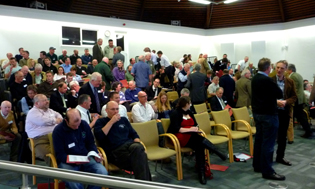 The Rivers and Fisheries Trusts of Scotland (RAFTS) has agreed a ground-breaking co-operation accord with Scottish Natural Heritage (SNH) in recognition of their common objectives for the better management of aquatic environments and fisheries and the conservation of native fish species. The Statement of Intent will be formally launched by both parties at the joint RAFTS and Association of Salmon Fishery Boards (ASFB) 2012 Conference being held at SNH’s Battleby Centre on Thursday March 29.
The Rivers and Fisheries Trusts of Scotland (RAFTS) has agreed a ground-breaking co-operation accord with Scottish Natural Heritage (SNH) in recognition of their common objectives for the better management of aquatic environments and fisheries and the conservation of native fish species. The Statement of Intent will be formally launched by both parties at the joint RAFTS and Association of Salmon Fishery Boards (ASFB) 2012 Conference being held at SNH’s Battleby Centre on Thursday March 29.
The joint statement re-affirms each organisation’s appreciation of the other’s interests, recognises the benefits of the public and private sectors forming strong and effective partnerships and details arrangements for future liaison and co-operation. It recognises that RAFTS’ research, advice and capacity to co-ordinate and deliver projects is now well proven and that Fishery Trusts are set to play an increasingly important role in securing the future of Scotland’s rivers and lochs and the diverse flora and fauna that they support.
Andrew Wallace, Chairman of RAFTS, commented: “RAFTS and SNH have, over recent years, been developing important partnerships around the shared objectives of better managing and conserving Scotland’s river catchments, their fish and fisheries. This document enshrines these aspirations and the need, in difficult economic times, for the public sector and third sector to work in a smarter, more effective way. With several strong existing partnership programmes already underway we can look forward to developing this relationship with confidence and optimism.”
Ian Jardine, Chief Executive of SNH, added: “SNH and RAFTS are committed to realising benefits from Scotland’s rich natural environment, particularly our fresh water. That relationship has been further strengthened by our joint statement of intent issued today which will drive what we do, and how we do it. Our natural capital is important to everyone in Scotland. Put simply, this is the recognition that our natural heritage is significant economically and provides associated health and well-being benefits for all of us.”
Mr Jardine continued: “An SNH poll in 2011 revealed 91% of people are glad that wild salmon are in Scotland’s rivers. Rivers and lochs are most highly valued assets and we are committed to working with partners to manage and conserve our freshwater environment. This is part of our natural capital which has a significant economic role and landscape and marine environments are a boost to Scotland’s Gross Domestic Product.”
Callum Sinclair, Director of RAFTS said: “For several years, RAFTS’ spring conference has been a pivotal event in the fisheries calendar. This year, for the first time and in recognition of the close working relationship between the two organisations, the 2012 conference is being jointly convened by RAFTS and ASFB. This provides an opportunity to present the positive contributions that fishery trusts and District Salmon Fishery Boards make individually and collaboratively to fisheries and environmental management and protection.”
Dr Alan Wells, Policy and Planning Director of ASFB welcomed the event, adding. “The four sessions concentrate on a range of topics of interest to fishery managers in Scotland with presenters from SNH, Marine Scotland Science and across the network of Boards and Trusts. Topics covered include the policy and legislative context for fisheries management, salmon genetics and related management applications, practical mitigation strategies where necessary and the promotion of better access to and use of fisheries.”
The conference will also mark the launch of the 2012 ASFB and RAFTS Annual Review. This focuses on many of the key threats to salmon and sea trout and details much of the latest research and practical projects being undertaken by Fishery Boards and Fisheries Trusts. The ASFB and RAFTS Annual Review is sponsored by legal firm Gillespie Macandrew and property consultants and land agents Strutt and Parker.
ASFB-RAFTS Annual Review (pdf) (March 2012)
